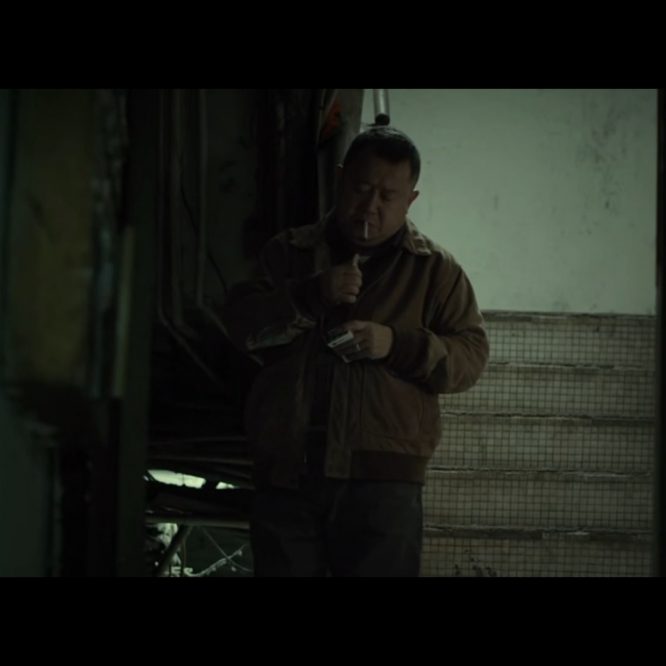MAD WORLD, DIR. WONG CHUN (2016)
Stairs Inside Tong Lau, Cheung Sha Wan, Hong Kong

Dong’s father is climbing up the stairs and that hurts his back. Scene from Mad World, 2016, directed by Wong Chun.
Released in September 2016, Mad World reveals the actual living condition of those underprivileged in Hong Kong and shows the lack of support for them, including the patients with emotional illnesses and low-income groups. The storyline focuses on the life of a bipolar victim, Dong, who has chosen to live with his father in a subdivided flat in a traditional Tong Lau after being released from the mental hospital. In past, the construction of Tong Lau in Hong Kong did not include elevators. Therefore, being the only pathway to in and out of the building, the stairs appear in several scenes and become an important place for shots of the characters’ activities in this film.
Dong looks at the living space in the corridor after being released from the mental hospital.

Scene from Mad World, 2016, directed by Wong Chun.

Dong’s father is smoking at the stairs as he blames himself for leaving Dong’s mother and him after all these years. Scene from Mad World, 2016, directed by Wong Chun.

Stairs at Tong Lau in Cheung Sha Wan District. Realistic.
Framed in different levels, from the ground floor to those upper, the stairs in this film are often presented in a blue color tone with weak lighting and dilapidated surrounding objects such as rusting windows frames and discolored walls, to give a compressed atmosphere to the audience. For example, one of the frames is set in a corridor that captures the space of stairs and corridor and Dong looks directly into the camera, which indicates the limited area between the living space and common area inside one building. Compared to the stairs in reality1, those in this film keep the ‘authenticity’ of the feeling given by the environment which also contains the senses of oppression and isolation from the urban city. Climbing up a number of stairs and turning around at each corner, the experience is unpleasant and exhausting, not to mention about the residents living there.

Dong is carrying his father while climbing upstairs to get back home. Scene from Mad World, 2016, directed by Wong Chun.
The setting in stairs contributes a lot in emphasizing the poor living quality of subdivided flats’ residents and witnessing the change in characters’ minds, especially Dong’s. One example includes a long shot of Dong carrying his father. This shot is placed after the shot that they have had an argument and eventually have become reconciled, to imply the fixed relationship between Dong and his father. The shot uses a warmer color and a higher context of lighting, indirectly representing the positive change in Dong’s mind. Moreover, it comes to the audience’s attention that there is no lift for his middle-aged father, who has broken his ankle and should not be walking on stairs, to further enforce the bad living environment. Last but not least, quoted from Wojcik (2018),’We can think about how a film situates us, makes us familiar, even if we enter as tourists.’, this film has reminded us the dark side of Hong Kong social system through giving us a visual experience. Not only can we resonate with the local life of the characters, but also the familiar view of Hong Kong such as Tong Lau and Stair Shops in old district.
—Chan Tsz Fung, 3035796139
Notes:
1 The actual site filmed in Mad World, which is an old Tong Lau, has been demolished in 2018. Therefore, stairs in other Tong Lau have been observed.
2 Wojcik, P. R. (2018). What Makes the Apartment Complex? In Urban Living and Global Screen Cultures (pp. 1-20), edited by Wojcik, P. R. Durham: Duke University Press.
Appreciate your attempt to visit and document an actual site. Since you visited a tonglau and documented it, it would contribute more to your analysis if you observe and documented more similar stairwells to discuss your points on the spatial quality and experience of the tonglau stair well. Or, you could consider documenting more details of the same stairs, and/or observing the stairs over time. Given your point that the stairs are an important space in the film not only as a static element in the tonglau but also as a dynamic element where things happen and play an important role in the plot narrative. Appreciate your discussion on contrast in lighting and color tonality. Other than your observation of the warmer color in the film as potentially “representing the positive change in Dong’s mind,” did you notice in your fieldwork what are the color tones of the stairwell over time? For example, how do the color tones of the stairwell (its walls, stairs, floor, and other elements) shift during the course of a day, from morning to evening? How does that compare to those in the film, especially in the scene you refer to towards the end? Do you learn something from your observation of the actual stairwell that allows you to reflect on the same scene differently? Do also cite your sources fully, including the exact location of the Tong Lau and other references that you needed to use for this fieldwork analysis.